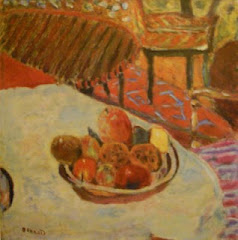 O! fond farewell to savages and explorations!—and to the great explorer, Claude Lévi-Strauss, anthropologist, philosopher, and author (most gloriously, of Tristes Tropiques), dead this week at 100, who wrote about so many things, from face-painting to tribal magic and its sorcerers to scented rums; finding a better way of being, in the canny glances of a cat; hearing a fragment of a Chopin Etude in a foreign place that brings one's own beginnings back. His might well be a guide to the considered life.
O! fond farewell to savages and explorations!—and to the great explorer, Claude Lévi-Strauss, anthropologist, philosopher, and author (most gloriously, of Tristes Tropiques), dead this week at 100, who wrote about so many things, from face-painting to tribal magic and its sorcerers to scented rums; finding a better way of being, in the canny glances of a cat; hearing a fragment of a Chopin Etude in a foreign place that brings one's own beginnings back. His might well be a guide to the considered life.
There's a wonderful tribute in The New York Times from November 4, "Other Voyages in the Shadow of Lévi-Strauss," by Larry Rohter, telling of his lasting influence on the tribes of the Amazon, not just on those of us who've been transformed by his profound and lyric masterwork. __________________________
A tribute also to Wallace Stegner, whose hundredth birthday year this would have been. There's a nice article in Orion this week about his work in connection with the environment, "Putting Things Back Together," by Rick Bass.
I am especially drawn to Stegner's work (especially Angle of Repose and The Spectator Bird), because I've been living and writing in his footsteps. Behind the Cathedral and its park in Santa Fe is the old St. Vincent’s Hospital, where I was born and where (though I was here by then, in his Palo Alto) Wallace Stegner was to die, after a car crash there in Santa Fe during a trip to give a lecture.
The allure of the little cottage where we live is its location—on a lane that has just three houses—in the Los Altos Hills. The township of Los Altos Hills was founded by Wallace Stegner and incorporated in 1956 (my birth year!). Strict zoning laws require every house to have at least an acre of undeveloped land around it. Altogether it’s eight and a half square miles of gently rolling hills and valleys, wooded areas with creeks and streams, vineyards and orchards, and seventy-five miles of walking, biking, and horseback riding trails.
Living here is almost like living in the country—or another country, even. There were sheep in the pasture beyond our fence when we moved in, and red clay tennis courts above, like some that charmed me in Aosta on my way to the St. Bernard Pass for the archaeology. Next door is a Jewish temple. The sheep are gone now, but a matched set of alpacas, like overgrown French poodles, has replaced them, and watch over the fence, hopeful for fallen pears.
image: Two indians of the brazilian Pataxó tribe, in traditional attire, during a demonstration ("O Abril Indígena") in Brasília, April 4th, 2006. Photographer: Valter Campanato/ABr.









,_1881.jpg)































